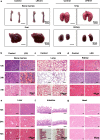The bone marrow niche components are adversely affected in sepsis
- PMID: 35006437
- PMCID: PMC8607421
- DOI: 10.1186/s43556-020-00010-3
The bone marrow niche components are adversely affected in sepsis
Abstract
Multiple organ dysfunction is an important cause of death in patients with sepsis. Currently, few studies have focused on the impact of sepsis on bone marrow (BM), especially on the cell components of BM niche. In this study, we performed mouse sepsis models by intraperitoneal injection of LPS and cecal ligation and puncture (CLP). The changes of niche major components in the mouse BM among vascular structures, mesenchymal stem cells and Treg cells were observed and analyzed. The results showed that pathological changes in BM was earlier and more prominent than in other organs, and various cell components of the BM niche changed significantly, of which vascular endothelial cells increased transiently with vascular remodeling and the regulatory T cells decreased over a long period of time. These results indicated that the components of the BM niche underwent series of adaptive changes in sepsis.
Keywords: Bone marrow niche; Lipopolysaccharide (LPS); Mouse model; Sepsis.
© 2020. The Author(s).
Conflict of interest statement
The authors declare that they have no competing interests.
Figures





Similar articles
-
Early severe impairment of hematopoietic stem and progenitor cells from the bone marrow caused by CLP sepsis and endotoxemia in a humanized mice model.Stem Cell Res Ther. 2015 Aug 14;6(1):142. doi: 10.1186/s13287-015-0135-9. Stem Cell Res Ther. 2015. PMID: 26272069 Free PMC article.
-
An increase in CD3+CD4+CD25+ regulatory T cells after administration of umbilical cord-derived mesenchymal stem cells during sepsis.PLoS One. 2014 Oct 22;9(10):e110338. doi: 10.1371/journal.pone.0110338. eCollection 2014. PLoS One. 2014. PMID: 25337817 Free PMC article.
-
Bone marrow stem cells and their niche components are adversely affected in advanced cirrhosis of the liver.Hepatology. 2016 Oct;64(4):1273-88. doi: 10.1002/hep.28754. Epub 2016 Aug 24. Hepatology. 2016. PMID: 27486864
-
Multiple myeloma bone marrow niche.Curr Pharm Biotechnol. 2009 Apr;10(3):345-6. doi: 10.2174/138920109787847493. Curr Pharm Biotechnol. 2009. PMID: 19355944 Review.
-
Bone marrow niche in the myelodysplastic syndromes.Leuk Res. 2015 Oct;39(10):1020-7. doi: 10.1016/j.leukres.2015.06.017. Epub 2015 Jul 14. Leuk Res. 2015. PMID: 26276090 Review.
Cited by
-
Assessing organ-level immunoreactivity in a rat model of sepsis using TSPO PET imaging.Front Immunol. 2022 Nov 10;13:1010263. doi: 10.3389/fimmu.2022.1010263. eCollection 2022. Front Immunol. 2022. PMID: 36439175 Free PMC article.
-
Impact of sepsis on bone marrow mesenchymal stem cells and its implications for hematopoiesis and immunosuppression.Inflamm Res. 2025 Aug 29;74(1):115. doi: 10.1007/s00011-025-02083-8. Inflamm Res. 2025. PMID: 40879757
-
Safety and feasibility of stem cell boost as a salvage therapy for severe hematotoxicity after CD19 CAR T-cell therapy.Blood Adv. 2022 Aug 23;6(16):4719-4725. doi: 10.1182/bloodadvances.2022007776. Blood Adv. 2022. PMID: 35793454 Free PMC article. No abstract available.
-
Immune-Mediated Adverse Drug Reactions (IM-ARDs) in the Form of Drug-Induced Immune Thrombocytopenia and Cutaneous Adverse Drug Reactions (CARD) Due to Clindamycin in an Human Immunodeficieny Virus (HIV) Patient.Am J Case Rep. 2023 Jan 5;24:e938358. doi: 10.12659/AJCR.938358. Am J Case Rep. 2023. PMID: 36600572 Free PMC article.
References
Grants and funding
LinkOut - more resources
Full Text Sources
Miscellaneous
